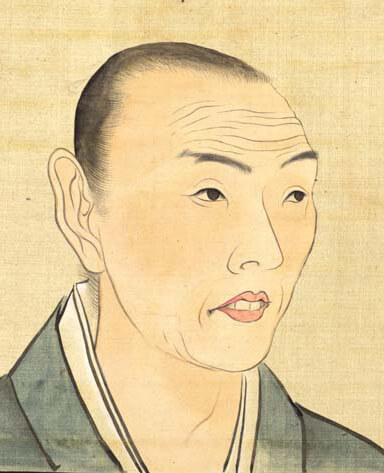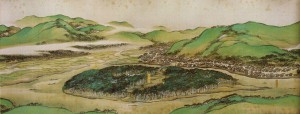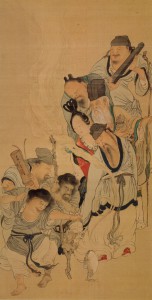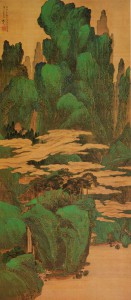Bunchou Tani / Kantou-bunjinga / Schools of Nihonga 007
Kantou-bunjinga
Kantou- bunjinga is a school of artists of the *literati painting that was active in Edo and led by Bunchou Tani (1763-1841). Well known artists of this school include Kyousho Tachihara and Kazan Watanabe. Bunchou’s works created during the Kansei period (1789-1801), especially, are called “Kansei Bunchou” and are held in high esteem.
*Literati painting:
The term bunjin means high-ranking officials or educated men and intellectuals who led a life away from the hustle and bustle of secular life; they were at the center of Chinese culture. The literati painting is the term used to refer to paintings that these men painted for their own enjoyment, and the word did not indicate a specific painting style at first. However, the literati painting gradually began to be painted intentionally. The ink painting was used as the main method of expression and common ideas in terms of theme and style exist in the literati painting. With its beginning in the Eastern Han dynasty, the literati painting reached its peak during the Northern Song dynasty and a defnite style of painting was established by the end of the Yuan dynasty. In the Ming dynasty, Dong Qichang (1555-1636) pointed out the superiority of the literati painting by categorizing it into beizonghua by professional artists and nanzoughua that express spiritual concepts. Paintings influenced by the literati painting of the Ming and Qing dynasties became popular during the Edo period.
*Nanga:
Nanga is a type of literati painting that was popular in Japan during the Edo period. The name has its origin in the nanzonghua of the Ming dynasty in China. The influence of nanzonghua is also strong in its style. Other styles of Chinese painting were also incorporated to give nanga its own unique style. Taiga Ike and Buson Yosa are famous nanga artists.
Bunchou Tani

Bunchou Tani self-portrait
Bunchou Tani (1763-1841) was a Japanese literati (bunjin) painter and poet. His name was Shouan. At the first time, his “gou” (second names) were Bunchou and Siryou, and then he changed his gou to Bunchou which was also used as his “azana” (pseudonym). He was generally called Bungorou or Naoemon. He was also called Shasanrou or Gagakusai, Muni and Ichien. After he shaved his head and was appointed Hougen-i (the second highest rank in the hierarchy of Buddhist priests), he was named Bun-ami. He was born in Shitaya-Negishi, Edo.
His Life
His Origin
His grandfather, Honkyou Tani, was originally a lower-ranked government official, but he became known as a statesman because he excelled in business, and he achieved superior performance, handpicked by the Tayasu family.
Painting Life
When he was 12 years old, he learned from his father’s friend Bunrei Katou of the Kanou school, and when he was 18 years old, he studied under a disciple of Kouyou Nakayama, Gentai Watanabe. Since Bunrei died when Bunchou was 20 years old, he studied under Kangan Kitayama and pursued Hokusou (Northern Song Period China) painting. It is said that he also studied under Fuyou Suzuki, which is not clear. After that, he learned the style of the Kanou school from Mitsusada Kanou, and he studied the styles of the Tosa school, the Rinpa school, Oukyo Maruyama and Goshun of Yamato-e painting (a traditional Japanese style painting), in addition to Korean and Western paintings. He planned a trip to Nagasaki and visited Kenkadou Kimura in Osaka when he was 26 years old, and he received formal instructions from Unzen Kushiro. After the death of Kenkadou Kimura, he expressed regret over his death and presented his portrait to the bereaved family. After he arrived at Nagasaki, he learned painting methods from Shuukoku Chou and stayed for about one month. Based on copies and sketches of ancient paintings and sketching, he eclectically mixed painting of various schools and aimed at a mixed style of north and south. His area of painting was wide, covering Sansui-ga (painting of mountains and rivers), Kachō-ga (painting of flowers and birds), portraits, and Butsu-ga (painting of Buddha), and additionally, he established his own painting style called Hasshuu Kengaku (syncretic study of all eight schools of Buddhist learning) and then he became a great authority of Kantou Nanga (a school of painting originating in China).
Painting School Shasanrou
Bunchou Tani established his private school called “Shasanrou,” where many disciples including Kazan Watanabe and Kyousho Tachihara learned. He explained importance of sketching and copying of ancient paintings, and his lectures focused on copying of paintings of Nanpin Shin. However, he did not get into methodism or formalism like the Kanou school but had educational attitude in which he respected personality or independence of disciples. Although he was famous as a teacher who well cared about his disciples, there are some criticism that he was authoritarian.
His wife Kankan Tani (the Rin clan) and his sisters Shunei Tani and Kouran Tani were also famous as women painters. The Tani family prospered as his biological younger brother Gentan Shimada was also good at painting and his adopted child Bun-ichi Tani and biological child Bunji Tani were also good painters. However, since Bun-ichi and Bunji who were regarded as his successors died young, Shasanrou then ruined.
Later Life
Bunchou was considered as one of Sampuku-tsui (triplicity) of Shitaya with Bousai Kameda and Houitsu Sakai and enjoyed his life, but he vigorously painted to the last breath. Sadanobu died in 1829, and Bunchou, who was 67 years old then, appointed as Goeshi (a painter for Shogun) and shaved his head. He was appointed Hougan-i and named Bun-ami at the age of 75.
He died in 1841. He was 79 years old.





